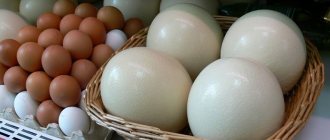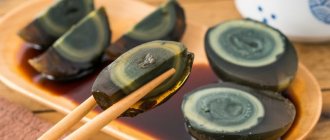Egg floating theory
Eggs are an unusual product that hides many secrets. For example, many people think that the shell is impenetrable, but this is not at all true, otherwise how can the chick breathe? The coating has micropores, invisible to the naked eye, and allows air to pass through.
And since there is a hole, there is access for microorganisms. It is because of harmful bacteria that the egg can spoil.
So, let's figure it out: how to determine the degree of suitability of a product without breaking the shell? We are not talking about ultra-modern electronic devices. We only need a glass of water and a “test” testicle.
Which egg doesn't float?
When we need to cook this product soft-boiled or hard-boiled, we take a pan and immerse the required number of eggs in cold liquid. Attentive housewives have noticed more than once that they usually immediately sink to the bottom, and this is the norm. Fresh chicken product always ends up on the bottom.
Let's figure out why this happens. The fact is that the activity of microorganisms always contributes to the release of gas, and gas is lighter than water, which is a liquid. And since the product is fresh and there are no harmful bacteria inside it in dangerous quantities, there is no gas in it either.
What kind of egg hangs in water?
If, after immersing an egg in a container of water, you see that it is hovering in the middle, between the bottom and the surface, do not be upset and angry with the seller for the stale product.
It is indeed not the first freshness, but it is edible and not at all dangerous.
The fact is that air has already managed to pass through the pores and accumulate between the shell and the thin film (when the shell is broken, it is visible to the naked eye). This phenomenon did not harm the product at all and did not deteriorate its quality.
Which egg floats with its blunt end
Raising the egg to the surface of the water with a blunt end indicates that such a product is already a week old and there is a certain vital activity of microorganisms inside it, which has made the contents less liquid (thickening it), but it is still suitable for consumption.
The main thing is to eat it as quickly as possible.
Which egg floats completely?
If the egg has completely floated to the surface, most likely your breakfast is spoiled, because enough gases have accumulated in it to push out the not-so-light product from the water.
Other ways to determine freshness
Marking
If the eggs are industrially produced, that is, they were laid by chickens at a poultry farm, then each of them is stamped with the exact date of production.
This is very convenient because you can always check how fresh the egg is.
Dietary eggs are marked in red, table eggs are stamped in blue with the obligatory indication of the category:
- highest (HV) – large, reaching 75 g;
- selected (SO) – quite large, 65-74.9 g;
- first (C1) – from 55 g;
- second (C2) – from 45 g;
- third (C3) – from 35g.
Be sure to check the date of manufacture when purchasing and give preference to poultry farms in your region.
To the light
There is a special device called an ovoscope; by the way, it’s easy to make with your own hands in just 5 minutes. It shines through the eggs and determines their freshness. If the yolk is in the center, then the product is suitable for consumption.
The presence of darkened areas near the white means that the testicles have been lying around for a week or two, but they can be eaten without any problems. And stale eggs are not translucent at all.
Since you most likely do not have a device, bring the egg to a light source with a power of at least 100 W and take a good look at it in the light.
The following factors indicate staleness:
- an air gap of more than 9 mm between the shell and the protective film;
- blood ring or large clots (pinpoint blood spots are allowed).
If you have an ultraviolet lamp, a fresh egg will show a bright red color, while a spoiled egg will show a pale purple or gray color.
Visual inspection
Start your inspection with the appearance of the shell; it should be rough and matte. Stale eggs have a characteristic shine and gloss.
Floating in salt water
There is an opinion that adding salt to the water before cooking will help maintain the integrity of the shell while it is heated.
However, if you decide to check the freshness of the egg directly in the pan, you cannot salt the water. Salt will change the chemical composition of water, thereby increasing the density of the liquid. The result will be inaccurate: a fresh egg dipped in salty liquid will not float to the surface.
Video: how to check the freshness of an egg using water
So, you can determine the freshness of eggs without even violating their integrity. This is very important, because when buying them even from the most familiar and trusted seller, you need to remember that no one is immune from mistakes.
A spoiled egg poses serious health problems, so it is better to dip the egg in cold, non-salty water before each meal for a tasty and, most importantly, safe breakfast.
How to choose and store eggs correctly
Before consuming eggs, you need to pay special attention to hygiene. You must adhere to the following recommendations:
- buy only fresh eggs and eat them before their expiration date;
- Eggs should be stored in the refrigerator at temperatures below 6°C. At this temperature, bacteria do not multiply. If the eggs are left in the room, the number of bacteria will increase;
- when preparing dishes where raw eggs are added, only the freshest ones should be used;
- you need to cook the eggs for at least 5 minutes;
- If the eggs have expired, they may still be suitable for consumption for a few more days, but only with careful preparation. Bacteria will die at a temperature of 70°C.
- Eggs should be used immediately if their shell is damaged. This product cannot be stored.
Reviews from netizens
The first, one might say, old-fashioned way, is with the help of water. As you know, the older the egg, the more air appears inside it. This happens because over time, the liquid gradually evaporates from the egg, and the white dries out. Which affects its buoyancy. A completely fresh egg dropped into water immediately sinks to the bottom, lying flat. After lying there for several days, it will already become “on the butt”, sticking up, with the pointed end up. Well, the old, bad egg will float on the surface.
The second way is more obvious - break an egg. Fresh whites will not spread over the entire bottom of the bowl, but will look like thick transparent jelly, and the yolk will resemble a half-deflated ball.
Well, finally, you can illuminate the eggs with a hundred-watt light bulb. The air chamber in this case will be immediately visible. You can also see dark spots, and the yolk will be pressed against the shell, which should not be the case.
Store-bought egg: 65 g, and from your own chicken: 105 g. Feel the difference.
Shelf life
When stored, an egg quickly loses its original properties, therefore it is classified as a perishable food product. The packaging always contains information about the expiration date, which you should pay attention to when purchasing. If storage rules are followed, the product will remain fresh. However, this information is not always reliable. It is unknown how long the eggs remained in the warehouse before being packaged and transported to the store. Also, to give it a marketable appearance, some manufacturers can wash and treat the shell with various means. Such eggs will spoil much faster.
It is also worth noting that a rotten smell can appear not only from bacterial decomposition. Over time, carbon dioxide begins to form and be released in the egg, and the amount of sulfur increases, which subsequently interacts with hydrogen. As a result of the reaction, hydrogen sulfide is formed. Such chemical processes occur faster at room temperature.
What does it mean when eggs float after being immersed in water?
Determining freshness by immersion in water is an ancient method that is still relevant today. The technology helps determine the suitability for human nutrition of products from any variety of poultry, including the rarest of them.
The embryos of farm birds float in cold water for two reasons:
- Long-term storage resulting in expiration of the shelf life.
- The product has deteriorated due to the penetration of pathogenic microorganisms.
What eggs don't float?
Embryos that sink to the bottom when immersed in water at room temperature (as well as in cold water) behave differently.
Table No. 1. Determination of the freshness of raw eggs drowning in a container of water.
A small quail egg can rise to the surface of the water, even when relatively fresh. This behavior is due to the insignificant mass of dry substances of the contents in relation to the developed air chamber and the tendency to dry out quickly. To get a definite answer about the freshness of the product, you will need to open it, although you still won’t be able to eat it.
What to pay attention to at home
Store-bought eggs can be further tested at home to obtain reliable information about their quality. In addition to immersion in cold water, there are other ways to determine the freshness of the product.
Example
If you break a fresh egg onto a flat dish, it will spread evenly, and the yolk will remain convex. The protein should be transparent, moderately viscous and thick. There are no foreign inclusions in the contents, except for a small spot in the part where the embryo is located.
Cooking and eating spoiled food means exposing your health and the well-being of loved ones to unjustified risks.
If an egg does not sink in water, but rises to the surface, it cannot be eaten, since the floating test reveals even biologically inferior variants that will not benefit the body.
Why do raw eggs rise from the bottom?
At the blunt end of the embryos of farm birds there is a puga - an air chamber. It is formed when the shell membranes diverge; as they ripen, the contents become increasingly filled with air.
In a laying hen-only product this space is not available. In chickens, for example, it forms within 6–60 minutes. The size of the puga is determined by:
- the size of the embryo;
- permeability of the shell to atmospheric gases;
- the rate of cooling of the product immediately after it leaves the oviduct;
- number of days of storage.
In large birds, especially turkeys and geese, the air chamber forms faster and is larger in size than in chickens or quails. This is due to increased evaporation of fluid from the structures of the embryo, corresponding to a larger surface area of the shell.
Moisture loss is due to the porosity of the shells. This structure is characteristic of embryos, since in fact they are living and developing organisms that require gas exchange.
The temperature difference after the embryo leaves the mother's body leads to compression of its internal structures, while the hard shell does not change its size.
The resulting empty space becomes a puga, and in some cases it is formed not at the blunt end, but in other places. Such embryos are unsuitable for incubation, but can be used as food.
Table No. 2. Change in the size of the air chamber depending on the age of the chicken embryo.
The egg floated during cooking: what does this mean?
When eggs float in the water, this is interpreted unambiguously: you have come across a product that is not the freshest. By the movement of an item in a pan, you can determine how long it has been on store shelves. To do this, pour cold water into a container and place the eggs before cooking. Wait for the local storm to subside and observe.
Housewives generally see the following stages:
- a dietary product that is no more than 8 days old lies on the bottom and does not attempt to rise to the surface;
- an egg that has lain for a week begins to move upward with its blunt end;
- A 2-3 week product hangs in a vertical position somewhere in the middle;
- the one that was taken from the chicken more than a month ago comes up completely.
See how the shelf life of a product is visually determined. This is exactly how eggs of varying freshness behave in cold water.
These characteristics apply to chicken and quail eggs. The results of the experiment are reliable; it is impossible to make a mistake in determining freshness. Unless you start using a boiled egg instead of a raw one or salt water. Salt increases the density of the liquid, the experiment will change under such conditions.
The following situation occurs: you are sure that the specimen is fresh, but it still pops up. There is no need to scold the experiment, just examine the egg. There are probably cracks in the shell through which air has entered. It is also better not to eat this as food - it is unknown how the bacteria that penetrated inside affected the quality of the protein and yolk.
How to determine the quality of a product when purchasing
It is impossible to test an egg in a store by dipping it in water or saline solution. Whether it sinks or floats up, it will only be visible at home, and only a limited range of characteristics is available for evaluation on the counter.
Particular attention should be paid to the conditions for placing packages, as well as their features.
- It is preferable that the egg storage temperature does not exceed +6 °C; it is better if the packages are in a separate refrigerator.
- Packaging made of paper or cardboard is preferable to plastic, as it does not interfere with the gas exchange of embryos if they are fertilized, and prevents them from breaking or cracking during transportation.
It is believed that plastic is more hygienic than cardboard, although in fact the material does not have a particular effect on the “morbidity” of eggs. You still won’t be able to see the product through a matte or whitish surface, but when using cellulose-based packaging, the amount of long-term decomposing waste is reduced and the threat of damage to the planet’s ecology is reduced.
Signs of a spoiled product
The first thing you should look at in the store is the shelf life indicated on the packaging. The product is considered dietary for a week, then it remains suitable for cooking for another 18 days.
The marking closest to the date of collection is applied to the shell, it indicates the day of sorting.
The shell of a good fresh egg has no cracks or foreign inclusions and is evenly colored. It remains matte and slightly rough for a long time, only leftover products become glossy and shiny. No dirt or blood is allowed.
In modern retail chains, ovoscopes are often present on tables for packaging products by customers. They allow you to check the quality of eggs from the inside. When examined, the following defects become visible:
- bloody inclusions;
- mold stains;
- small cracks in the shell;
- melted yolks.
Foreign odors become noticeable when you bring food closer to your nose. If an unpleasant odor appears (hydrogen sulfide, rot, rotten flesh), it is better to hand over the packaging to the administrator.
It is also permissible to shake the egg in your hand; it should not make any extraneous sounds or gurgles.
Why do eggs float in water?
The question can be answered with the same simple observation. As soon as the opportunity arises, compare 2 products: only from poultry and from storage. They will have a couple of significant differences that cause the eggs to float to the surface.
What does it mean? The properties change because the shell is not airtight. It has pores that allow oxygen and microorganisms to pass through so that the potential chick has the opportunity to survive. A certain environment is formed inside the product. If it is not cooled in time or thermally treated, pathological microorganisms will take over.
Checking the quality of eggs with an ovoscope
The ovoscope is a device that has been used since ancient times and is still used today to check the quality of eggs. This simple device is a flashlight with a directed beam of light.
You can check eggs with an ovoscope at home. It is easy to make at home:
- To do this, you will need a regular flashlight or lamp.
- Place the flashlight in a light-proof box so that the light comes from above.
- You need to make a hole in the top of the box that is smaller than the size of the egg.
- Place the egg itself on this hole and examine it carefully.
A good quality young egg has a smooth surface and an even color without spots or blemishes.
. Inside an egg whose storage conditions have been violated, you can sometimes even see a chick being born.
This is noticeable by bloody clots inside the shell and specific outlines. A rotten egg, when examined with an ovoscope, will have an unpleasant cloudy tint.
Important
! To keep eggs fresh longer, they do not need to be washed before storage, so as not to damage the protective layer of the shell.
Useful video
Eggs are a complete source of protein, which is why fans of a healthy lifestyle love them. But it is very important to monitor the quality of the product used. You can check eggs for freshness immediately after purchase, since this is unlikely to be possible in a store or market.
Is it possible to eat eggs that float in water?
If an egg floats in water during cooking, its further fate depends on its freshness. A completely floated product should not be eaten. Immediately add this to your cart. It is allowed to eat something that has been sitting for 2-3 weeks, only the egg must be boiled until fully cooked. It is better not to poach or scrambled eggs with semi-liquid yolk and white. Health is more valuable.
Feel free to eat daily and weekly specimens. First of all, try to use the latter so as not to spoil. To avoid unpleasant consequences, choose dishes that require high-quality heat treatment of eggs - salmonella is also found in the freshest eggs.
Determining freshness using water
For testing we will need:
- A deep saucer, preferably transparent.
- Cold water.
- Eggs.
This method makes it easy to determine whether eggs can be eaten or should be thrown away. Our grandmothers also used it.
- Place the bowl on a flat countertop and fill it with water, almost to the brim.
Place the egg in the water carefully so as not to break it on the bottom. It either sinks or floats.
Those that floated to the top should be thrown away. They've gone bad. If a raw egg floats in water, it is not fresh. This rule applies only to clean water. Everyone floats in salty water due to the increased density of water. For the same reason, the protein does not come out of a cracked shell when cooked. The salty liquid squeezes it.
Testicles that have sunk but are standing upside down indicate the end of their shelf life. You can still eat them, they won’t do any harm. From the expiration date on the box, you can eat them for another three weeks. But be sure to test for freshness this way.
Those that have drowned and lie on their sides at the bottom are the freshest. They can be eaten immediately or stored in the refrigerator. The optimal temperature for storing the product is +4 degrees.











